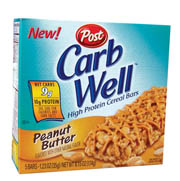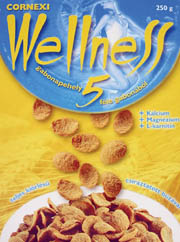
Health and wellness is a trend seen throughout just about every major food and drink category these days. Therefore, it is not surprising that this is the primary trend observed throughout ready-to-eat (RTE) cereals, cereal bars and health bars. Interestingly enough, “good-for-you” products are seen more often than convenience and portability, as consumers (while still looking for convenience in products) are concerned more with health and diet. However, convenience and portability were not ruled out as top trends, and such introductions were common occurrences, as was the continued presence of products positioned toward children. Flavor differences between RTE cereals, cereal bars and health bars also provide some interesting movements of note.

Healthy Differences
In 2004, the majority of new RTE cereals, cereal bars and health bars were positioned as “low in ___” (cholesterol, sugar, calories, etc.) and fortified with vitamins and minerals. These products often carry more than one claim; for example, Kraft Foods (Northfield, Ill.) launched Post Selects Cranberry Almond Crunch Cereal with Craisins. The cereal is free from cholesterol and high in folic acid, while containing 11 vitamins and minerals.Additionally, U.S. Mills (Needham, Mass.) released Uncle Sam Cereal Bars--cereal bars free from trans fat and said to be a good source of calcium, iron and fiber. They also are low in fat and formulated with vitamins and omega-3 fatty acids from flaxseed. Regarding health bar introductions, the focus often was geared toward a “low in ___” claim as well, but the addition of protein was another frequent find, as seen in EAS' (Golden, Colo.) introduction of its Myoplex Lite New & Improved Nutrition Bars. These bars contain 15g of added protein and 46% fewer calories than the original.
While some trends may overlap, there were quite a few notable differences in trends among RTE cereals, cereal bars and health bars. In regards to “low in ___” claims, “low-carb” was more likely to be seen with cereal bars and health bars. This is correlated to specific eating occasions, as well as the audience to whom low-carb products are marketed--consumers looking for a “quick fix” and those on the go. Smaller companies were more prone to release these products, such as Biochem's (Hauppauge, N.Y.) introduction of its Lo Carb Breakfast Bars. The bars are low in sugar and contain only 2g of net impact carbs (available flavors include blueberry muffin, chocolate donut, cinnamon bun, chocolate croissant and banana nut). Masterfoods USA (Hackettstown, N.J.) also extended its Snickers Marathon line (first introduced in 2003) to include Marathon Low Carb Lifestyle Energy Bar, which contained only 3g of new carbs.
Oppositely, RTE cereals touted as being low-fat increased just over 50% between 2003 and 2004, while the same claim among cereal bars decreased 55% (partially due to the increase in low-carb introductions). The presence of low-fat choices in RTE cereals can be attributed to the fact that cereals often are eaten in homes where families are present. Therefore, it is a healthy choice for parents and children. Unlike low-carb cereal bar introductions, low-fat products primarily have been launched by larger companies, as well as retailers.
Dominick's Finer Foods (Oak Brook, Ill.), for example, released Oats & More Cereal with Strawberries--a low-fat, toasted, multi-grain cereal that contains honey oat clusters and real strawberries. It also provides 10 vitamins and minerals.
One additional trend seen within RTE cereals is positioning toward children. Of all RTE cereals introduced in 2004, 13% were targeted to children (in comparison to 6% in 2003). Furthermore, many of these products claimed to be low in sugar. This was especially important, as they provided a healthier alternative to the typical sugary cereals introduced in the past (particularly good news for parents!). For example, General Mills (Minneapolis) extended its popular Trix, Cocoa Puffs and Cinnamon Toast Crunch cereals to include a low-sugar variety, with 75% less sugar than the original; the cereals also have 10-12 essential vitamins and minerals, as well as calcium.
Apart from “low in ___” claims, whole grains also were popular, particularly in RTE cereals. This had much to do with the new food pyramid regulations that, beginning tentatively in January 2005, were expected to focus heavily on the consumption of more whole grains. A great example of this was the inclusion of the following text on General Mills' packaging: “All General Mills cereals are made with whole grain.” This activity was observed heavily in the last two quarters of 2004, and no doubt will continue through 2005. An additional introduction of note included Kraft Foods' Post Healthy Classics Bran Flakes--a whole grain wheat cereal containing 20% of the daily value for fiber. It also was said to help reduce the risk of heart disease.
Convenience and Portability Still in the Mix
Of course, while health and wellness took the center stage this year, convenience and portability were not forgotten. Given the fact that cereal bars and health bars are convenient from the get-go, the focus here is on a few new introductions in RTE cereals.
In January, Kellogg launched an innovative product, described as a “cup-within-a-cup.” Its new Drink 'N Crunch line was a portable breakfast cereal in a cup advising consumers to “just add milk.” The product was described as a cup-within-a-cup, containing 1.27oz. of Kellogg's cereal--varieties available include Crunchy Blends Low Fat Granola, Fruit Loops and Tony's Frosted Crunch sweetened corn cereal. The package included an inner plastic cup containing the cereal, while milk could be added to a fill line in the outer plastic cup. After adding the milk, the inner cup could be snap-fit back inside. The milk and cereal then could be consumed straight from the cup, through an aperture in the lid, with no need for spoons or bowls, and no mess. Another example of convenience within RTE cereals was General Mills' new Go Bags--individual pouches of dry cereal said to be portable and snackable, available in its Golden Grahams and Cocoa Puffs varieties.
Flavor Choices
The presence of actual fruit bits and pieces in RTE cereals was “fruitful” in 2004. Strawberry and berry were the most popular fruit flavors among the bunch. Examples of these particular products included General Mills' introduction of its Total Whole Grain Cereal with Strawberries--a lightly sweetened cereal that contained real pieces of strawberries. Retailer Albertson's (Boise, Idaho) also launched Mixed Berry Toasted Oats Sweetened Whole Grain Oat Cereal. The cereal features real strawberries, blueberries and raspberries.Oppositely, in cereal bars and health bars, the presence of fruit was less common, but with chocolate and cinnamon flavors gaining substantial ground. This could be attributed to the fact that many cereal bars and health bars are positioned as healthy and often flavored with an indulgent ingredient--enticing the consumer who wants a tasty (but nutritious) treat.
For example, Kashi (La Jolla, Calif.) extended its Go Lean line of Protein & Fiber Bars to include Crunchy! Chocolate Peanut Bliss and Crunchy! Chocolate Caramel Karma varieties. The all-natural bars were formulated with calcium, folic acid and vitamin E. Another perfect example of this was Atkins Nutritional's (Ronkonkoma, N.Y.) Morning Start Double Chocolate Muffin Breakfast Bars--breakfast bars containing only 2g of net carbs per serving.
More for the Kids
As mentioned above, there has been a significant increase in the number of products targeting children. However, it is important to note there is more going on than just RTE cereals being positioned as low in sugar. In 2004, Clif Bar (Berkeley, Calif.) launched Clif Zbar Baked Snack Bars--healthy snack bars said to be a nutritionally appropriate portion size for kids, as well as an organic and natural alternative to other snacks for kids. The bars contained no trans fat and were available in Chocolate Brownie, Peanut Butter and Caramel Apple varieties.
Looking past health claims, most products for children were packaged to entice and grab attention--particularly through promotional marketing. For instance, Kellogg's packaging throughout the year promoted movies such as Finding Nemo, Spider-Man 2, The Incredibles and SpongeBob SquarePants. Kraft took a slightly different approach, targeting families by re-packaging typical children's cereal (Fruity Pebbles, Cocoa Pebbles and Oreo O's) to include the words “Family Size” on the boxes.

Blurring the Lines
Between 2003 and 2004, there were two significant crossovers, as confectionery brands moved into the health and snack bar category. The 2003 introduction of Masterfoods' Snickers Marathon started the initial movement, as the well-known brand crossed over into the energy bar category. The product proved successful, introducing two range extensions in 2004. The second crossover was Hershey's (Hershey, Pa.) new Snack Barz--snack bars made with Hershey's chocolate crème dipped in real Hershey's milk chocolate. These two products set the stage for other companies to do the same. However, when this occurs, lines often become blurred--is it a candy bar or a health bar?The Future
With the rollout of the new food pyramid and ongoing publicity surrounding obesity and the American consumer, health and wellness will remain a top trend in RTE cereals, cereal bars and health bars throughout 2005. Expect the addition of whole grains in additional RTE cereals, as well as a continuation in low-carb activity throughout cereal bars and health bars. In regards to convenience and portability, it would not be surprising to see more companies begin to roll out products similar to Kellogg's Drink 'N Crunch line, as this is a more unique way for RTE cereals to compete with cereal bars. In terms of flavors, there will be more fruit in RTE cereals, and more indulgent flavors in cereal bars and health bars.
The information in this article was derived from Mintel International's Global New Products Database, www.gnpd.com, 312-932-0400
Sidebar: Going Global
In RTE cereals, cereal bars and health bars, a common global trend observed was functionality, particularly through the addition of ingredients intended to specifically benefit health. An example includes Vogel's (Kerava, Finland) U.K. and Australian launch of its range of premium breakfast cereals that contain Hi-maize--a functional prebiotic ingredient said to help improve bowel movements.Another interesting example is Cornexi's (Tobak, Hungary) launch of its Wellness 5 Cereals in Hungary. The cereal is fortified with calcium (to prevent osteoporosis), magnesium (to help reduce cholesterol levels), and L-carnitine (claimed to reduce body fat, support healthy heart functioning and give extra energy). Often found in weight-control products, L-carnitine has a positive effect on metabolism.
PHOTOS COURTESY OF MINTEL INTERNATIONAL'S GNPD